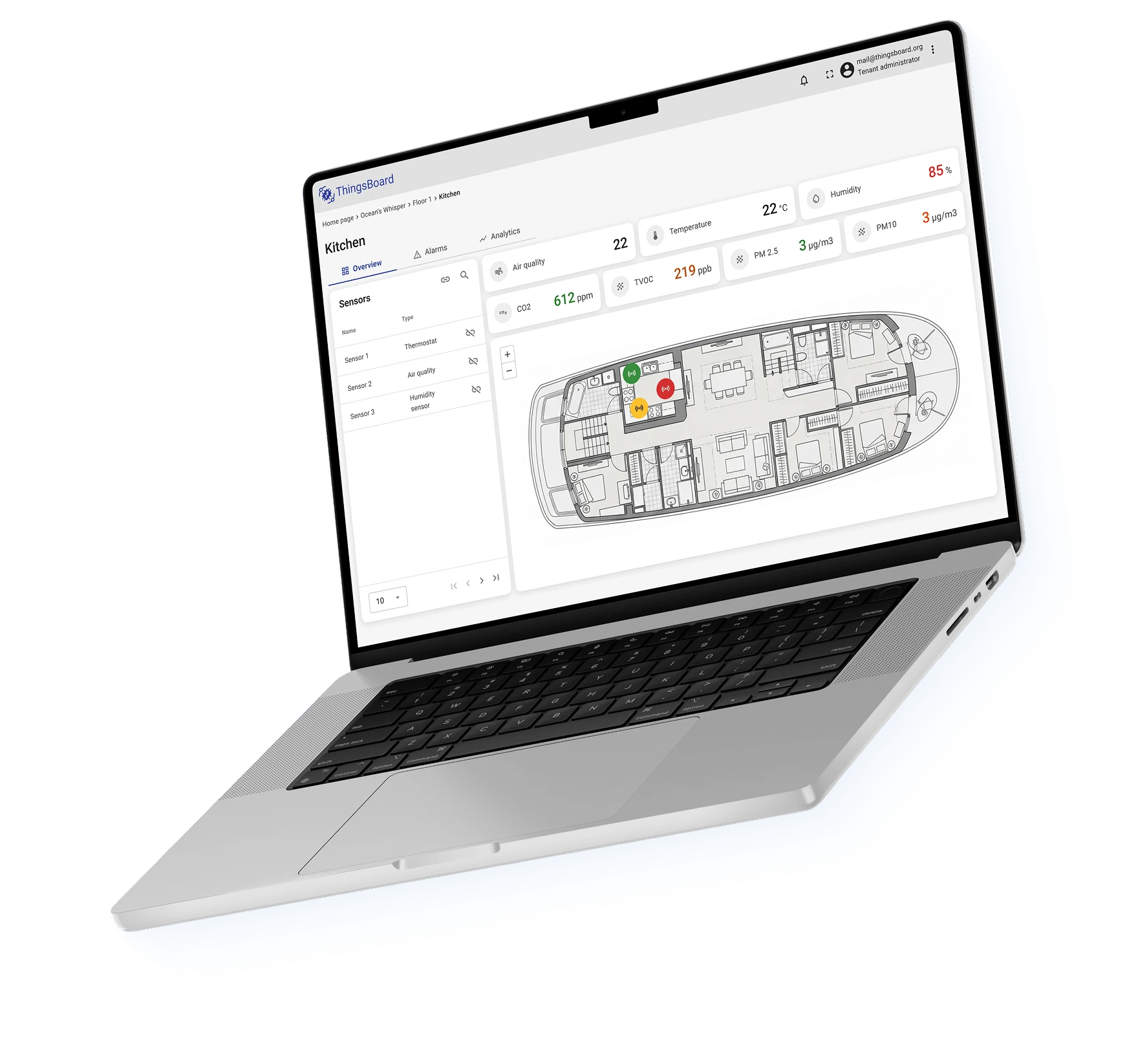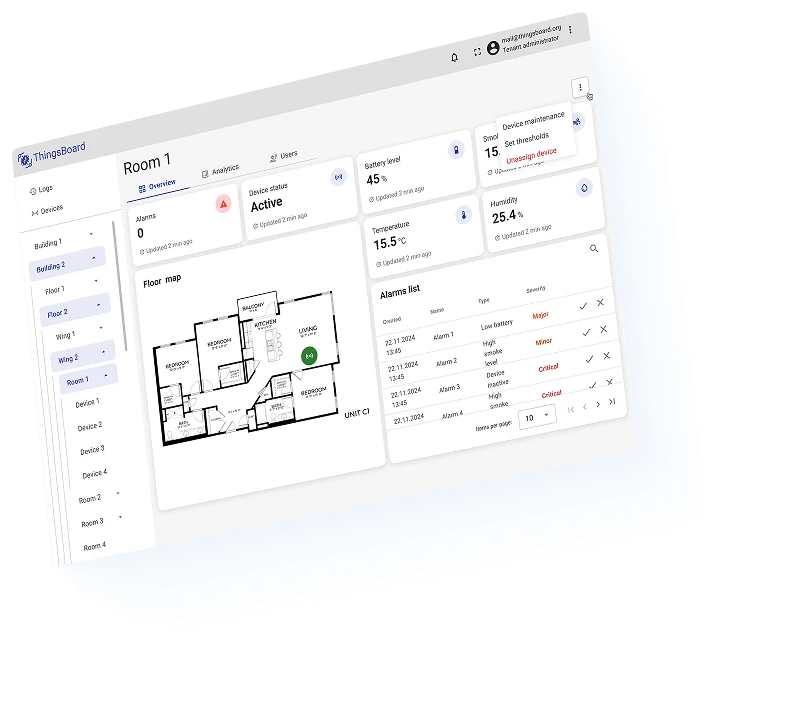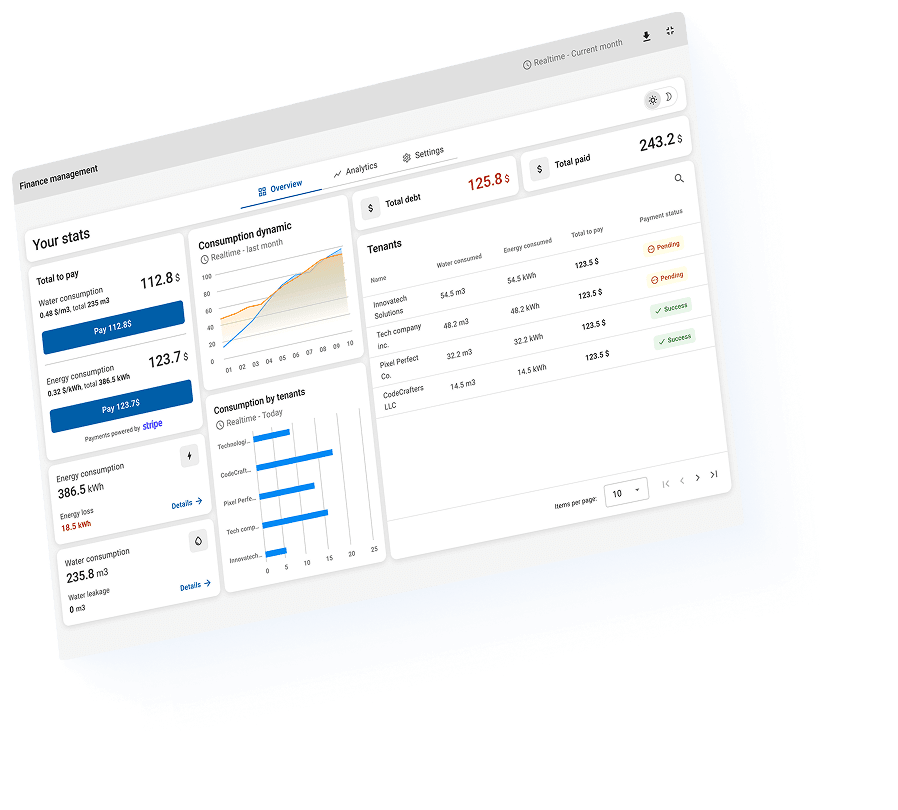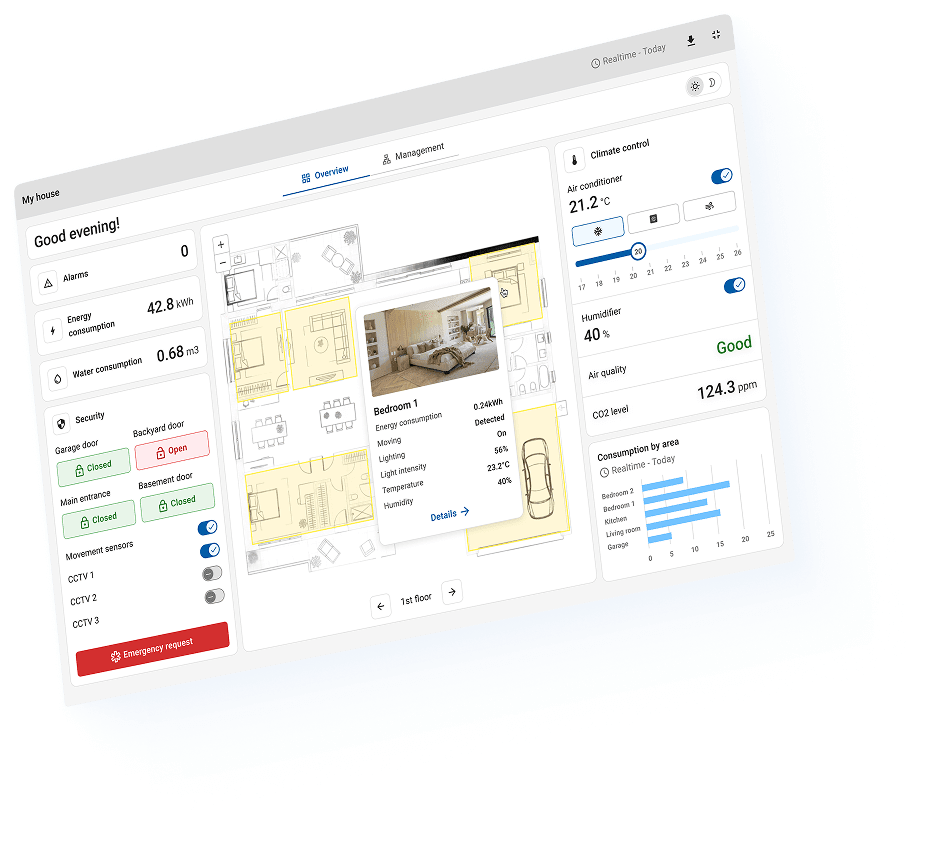



1
years in IoT domain
1
countries
1 +
delivered projects
1 %
success rate
1 %
clients engage us again


In IoT, data and dashboards mean nothing if they don’t create real business value. At ThingsBoard, our Development Unit makes sure your solution does exactly that.
We don’t just build features — we help you turn ideas into results. With our platform and experts, your technical goals are covered, so you can stay focused on your business impact. From optimizing supply chains to launching smart services, we ensure the tech drives results that matter — to your customers and your bottom line.


















65% of our clients build 2+ solution with us
| Why it matters | What it gives | |
|---|---|---|
| ThingsBoard at the Core | We build on ThingsBoard’s micro-service stack and re-using components instead of wiring them from scratch | 8× faster process: regular 8-month MVP delivered in just 1 month |
| Low-code accelerators | Dashboards, workflows, and rules are configured, not coded | About 70 % of UI built via drag-and-drop |
| Vertical starter kits | Reusable blueprints for 10+ industries cut uncertainty and tighten estimates. | 40 – 50 % of configuration is reused across engagements |
| Architecture-as-a-Service | Scaling, HA, observability, and DevOps patterns come pre-hardened and cloud-agnostic | Scalable production-ready setup for 50k msg/s deployed in 5–8 days |
| Fixed-price transparency | Budget is locked on day one; no surprises down the line | Projects delivered on agreed cost and timeline |
Why it matters
What it gives
We build on ThingsBoard’s micro-service stack and re-using components instead of wiring them from scratch
8x faster process: regular 8-month MVP delivered in just 1 month
Dashboards, workflows, and rules are configured, not coded
About 70 % of UI built via drag-and-drop
Reusable blueprints for 10+ industries cut uncertainty and tighten estimates.
40 – 50 % of configuration is reused across engagements
Scaling, HA, observability, and DevOps patterns come pre-hardened and cloud-agnostic
Scalable production-ready setup for 50k msg/s deployed in 5–8 days
Budget is locked on day one; no surprises down the line
Projects delivered on agreed cost and timeline

“We operate in highly competitive markets; from housing management to utilities and manufacturing sectors. Technology innovation is at the heart of our product strategy and service delivery approach. As we grow and extend our field service management solution, we recognised that we needed a flexible IoT platform that enables our delivery needs with lower complexity and co... read more
This timeline shows the key milestones in our development process, from the initial technical discussion to production deployment and maintenance. It is a structured framework that we adapt to the specific needs of client project
| Steps | Week 1 | Week 2 | Week 3 | Week 4 | Week 5 | Week 6 | Week 7 | Week 8 |
|---|---|---|---|---|---|---|---|---|
| 01. Technical Workshop |
1-3 sessions A working session with our solution architects and your team. We map your business objectives to concrete technical requirements and define the functional scope of the solution. |
|||||||
| 02. Scope & Proposal |
5 days Based on the workshop, we prepare a technical proposal. It includes the detailed system architecture, project scope, a fixed-cost breakdown, and an implementation plan with clear deliverables for each phase. |
|||||||
| 03. Project Kick-off |
2 days Once the proposal is approved, we sign the contract and provision the dedicated project environment (development, staging, production). The assigned engineering team begins work. |
|||||||
| 04. Iterative Development |
Scope-dependent (from 1 week) The solution is built in agile sprints (typically 2 weeks). Each sprint concludes with a demo of the new functionality for your team to review and provide direct feedback, ensuring the project stays aligned with the goals. |
|||||||
| 05. Iterative Testing & Validation |
Scope-dependent (from 2 weeks) The solution undergoes a complete testing cycle, including functional, integration, and performance testing. We then proceed to User Acceptance Testing (UAT) with your team to formally validate that all requirements have been met. |
|||||||
| 06. Deployment |
2 days Following successful validation, we deploy the solution to the production environment. The go-live process follows a pre-agreed plan designed to ensure a smooth cutover. |
|||||||
| 07. Support & Maintenance |
Ongoing Post-launch, we offer optional Service-Level Agreements (SLAs) for ongoing system maintenance, technical support, and planning for future feature development. |
1-3 sessions
A working session with our solution architects and your team. We map your business objectives to concrete technical requirements and define the functional scope of the solution.
5 days
Based on the workshop, we prepare a technical proposal. It includes the detailed system architecture, project scope, a fixed-cost breakdown, and an implementation plan with clear deliverables for each phase.
2 days
Once the proposal is approved, we sign the contract and provision the dedicated project environment (development, staging, production). The assigned engineering team begins work.
Scope-dependent (from 1 week)
The solution is built in agile sprints (typically 2 weeks). Each sprint concludes with a demo of the new functionality for your team to review and provide direct feedback, ensuring the project stays aligned with the goals.
Scope-dependent (typically 1-2 weeks)
The solution undergoes a complete testing cycle, including functional, integration, and performance testing. We then proceed to User Acceptance Testing (UAT) with your team to formally validate that all requirements have been met.
2 days
Following successful validation, we deploy the solution to the production environment. The go-live process follows a pre-agreed plan designed to ensure a smooth cutover.
Ongoing
Post-launch, we offer optional Service-Level Agreements (SLAs) for ongoing system maintenance, technical support, and planning for future feature development.

We manage the entire development lifecycle, from initial architecture to final deployment, delivering a production-ready solution on a fixed timeline and budget.
Analyze business processes to define effective IoT strategy
Design system architecture and identify areas for improvement
Develop detailed roadmap for successful IoT solution implementation

Dedicated cross-functional team

A single, expert point of contact managing the entire project

Maximum development speed by leveraging our pre-built components

We integrate our ThingsBoard experts directly into your team, providing specialized skills to accelerate your project and overcome specific technical challenges.
Fill a specific skill gap (e.g., in architecture, edge, or data science) in your in-house team
Accelerate a project that is already in progress and needs a boost
Upskill your team by having them work alongside leading IoT experts

Targeted expertise to solve your most complex challenges

Flexible access to elite engineering talent

Seamless integration with your existing Agile/Scrum workflows

Valuable knowledge transfer that strengthens your internal team for future projects

Working with the ThingsBoard Development team on our custom Mobile App has been an outstanding experience.
The development process was smooth, well-structured, and highly professional. From the initial requirements gathering to the final delivery, the team demonstrated deep technical expertise and a clear understanding of our vision.
The development team was highly responsive, transparent, and easy to work with, keeping us informed at every milestone. Any questions or concerns were addressed promptly, which gave us confidence that the project was always on track.
The final mobile app exceeded our expectations. It’s user-friendly, visually appealing, and performs reliably in real-world use. The mobile app was also designed in a way where my team could maintain widgets in the app without depending on mobile app developers.
Read more
This custom development has played a key role in advancing our business goals. The mobile app has allowed us to better serve our customers, and bring our IoT data to the palm of their hands in a seamless way. It’s already proving to be a valuable tool for both our team and our clients.
The fixed-price, fast delivery approach worked perfectly for us. It gave us cost certainty, kept the project moving at a great pace, and ensured that we met our timelines without compromising on quality.
We look forward to working with the ThingsBoard team again in the future and highly recommend their services to anyone looking for expert IoT and mobile development!
CIRCUTOR has over 40 years’ experience working on the design and manufacture of units for improving energy efficiency: electrical energy, power quality measurement and control units, industrial electrical protection, reactive energy compensation, and harmonic filtering.
CIRCUTOR owns a wide portfolio of connected energy control and metering devices. Despite the diversity of proprietary and off-the-shelf data protocols, Thingsboard has made it easy to accommodate most of our products in a common data platform.
I am deeply impressed by the dynamism and professionalism of the Thingsboard team. I appreciate greatly the ability to attend our technical suggestions and adopt them in the form of new functionalities. I highly recommend Thingsboard for its reliability, its flexibility and above all, the quality of the product and its technical service.
Working with the ThingsBoard team throughout this project has been a very positive and productive experience. From the beginning, the development process was well-structured and collaborative. The team supported me in migrating device communications, configuring message flows, and building a complete messaging system tailored to my needs.
They also guided me through setting up critical components such as data history storage, the early warning system, and automated monthly reports. Each stage of the development was handled with great attention to detail, always ensuring that the solutions aligned with the system architecture and functional goals.
Communication has been clear, responsive, and solution-oriented. I always felt that I had a reliable partner on the other side, ready to face challenges with me, especially when integrating ThingsBoard’s services with third-party tools. Their willingness to adapt and help troubleshoot integration issues in real time made a huge difference.
The final result is a robust, scalable system that performs exactly as envisioned. I also appreciate their continued openness to collaborate on the next stages of the project.
End-to-end rental management solution with IoT, multi-channel alerts, and branded interface
We have reached out to ThingsBoard to build a rental operations dashboard for managing rental stations that offer our products. Additionally, we wanted to provide those stations with a ready-made interface for fleet and contract management.
The solution needed to support rental contracts, performance reporting for rental centers, fleet management, geofencing, internal incident reporting, and multi-channel notifications (SMS, email, WhatsApp), along with real-time IoT connectivity to our products via MQTT.
Given time constraints, we chose to outsource the development so our internal team could focus on other priorities. Working with the ThingsBoard team proved to be efficient, with just the right level of collaboration needed to deliver an optimal outcome.
The final product met our expectations, featuring a user interface aligned with our brand’s design language and enabling rental centers to manage operations easily, safely, and in a centralized way.
IoT development services cover the design, development, deployment, and maintenance of IoT solutions. They include the creation of software ecosystems that allow you to manage communication between devices, collect data, map ingested data to digital twin, visualise it, and work as one integrated system. Think of smart electricity, water, heat meters, wearable health monitors, or asset tracking devices that provide critical information about asset health, allow decision makers to effectively strategies and improve the efficiency of key operational aspects. IoT development services bring these innovations to life.
Key IoT development services:Almost every industry can benefit from the IoT, including manufacturing, healthcare, retail, logistics, agriculture, energy, automotive, smart cities, education, and construction. IoT helps to improve efficiency, safety, productivity and provides companies with critical data tailored to their unique needs of each sector.
The main challenges of the IoT include ensuring seamless connectivity of all devices, data security and privacy, managing large amounts of information, visualising and analysing the data, ensuring that different devices work together and meeting the high requirements of industry standards.
No, you don't need to have hardware to start developing, you can add it in the next phases of the development process, and use simulated data to start with. But for a full product, IoT solutions usually require specialised hardware, such as sensors and gateways for data collection and transmission. The specific hardware depends on the goals of your project, such as temperature monitoring, location tracking, or remote equipment management.
An IoT platform is software that helps you easily manage connected devices, collect data, and visualise it in a clear and easy way. If you plan to effectively manage multiple devices and data streams, you'll definitely need an IoT platform, and we recommend using an IoT platform like ThingsBoard.
Development time is highly dependent on many factors, such as your specific needs, hardware availability, required integrations; simple projects can take weeks, while more complex ones can take several months.
Yes, we offer ongoing support, including problem analysis, problem resolution, upgrades, scaling services, and continuous enhancements to ensure your IoT system is running smoothly and meeting your ever-changing needs.
Yes, existing IoT solutions can be easily integrated with ThingsBoard. We help with seamless integration, ensuring that your current setup receives enhanced functionality and improved management capabilities.
Costs depend on the complexity of the project, hardware requirements, custom software development needs, integration with existing systems, and ongoing support needs. Each of these elements can have a significant impact on the total investment in your IoT project.
Taking into account industry standards and regulations (HIPAA, GDPR, etc.). Regular audit of infrastructure and application security. Development of a comprehensive security strategy (encryption, multi-level authentication, access control).
We keep the IoT secure with strong encryption, multiple levels of authentication, and strict access controls. We also regularly audit our systems and comply with regulations such as GDPR and HIPAA to ensure your data is fully protected.

